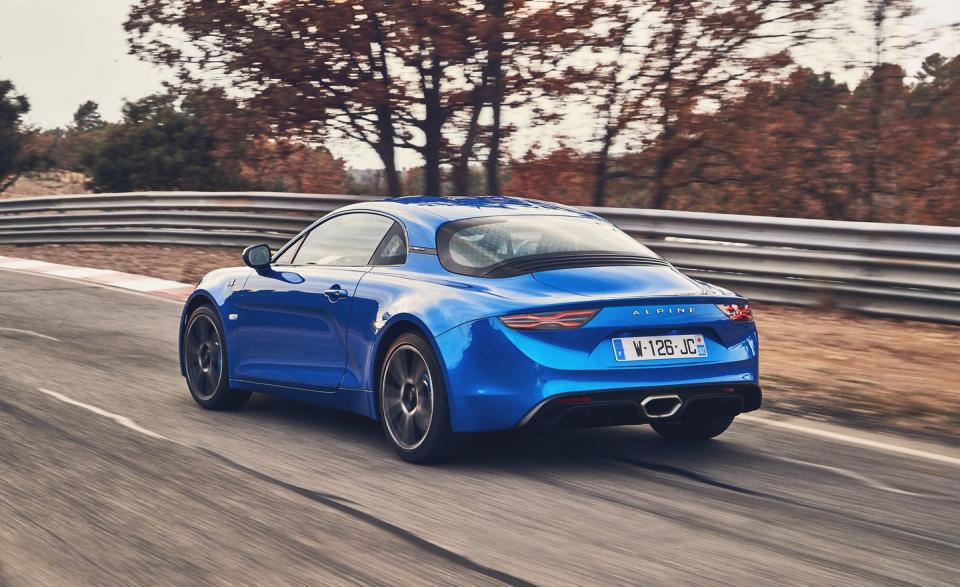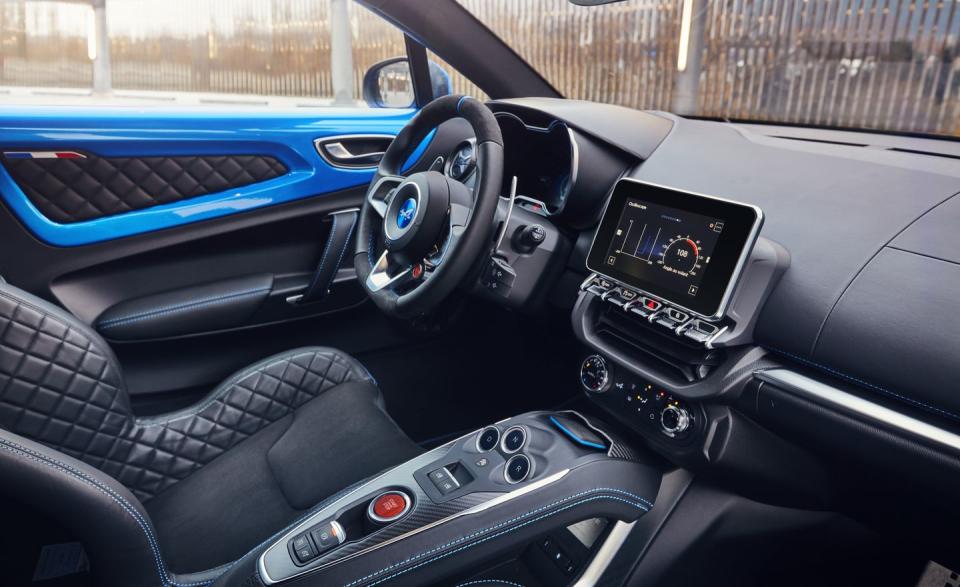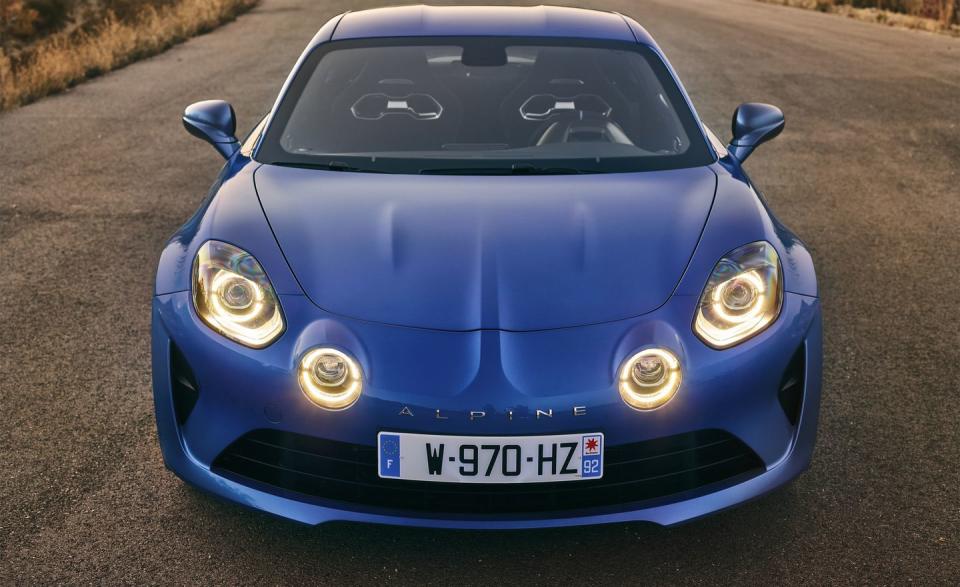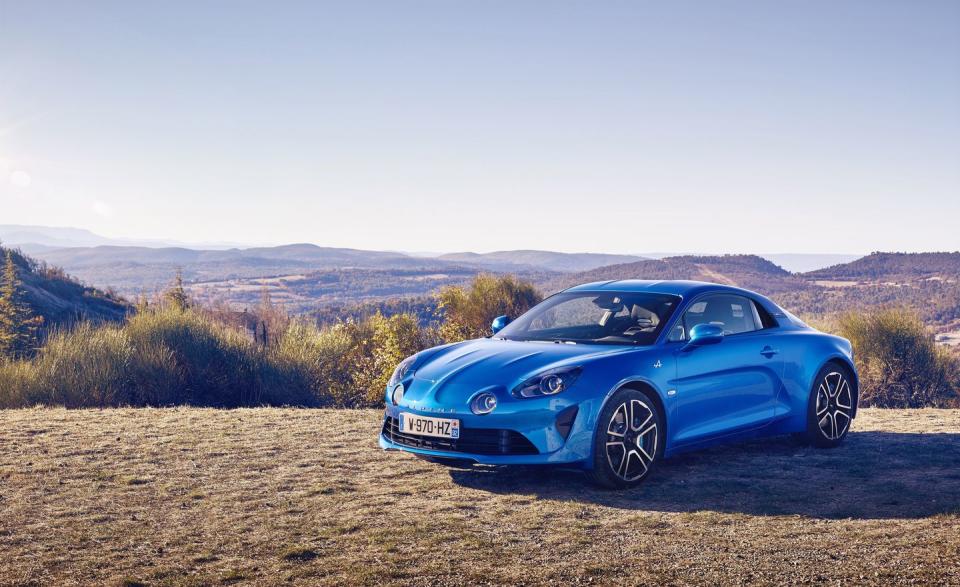Renault's Alpine A110 Is a Lithe and Lively Mid-Engined Sports Car
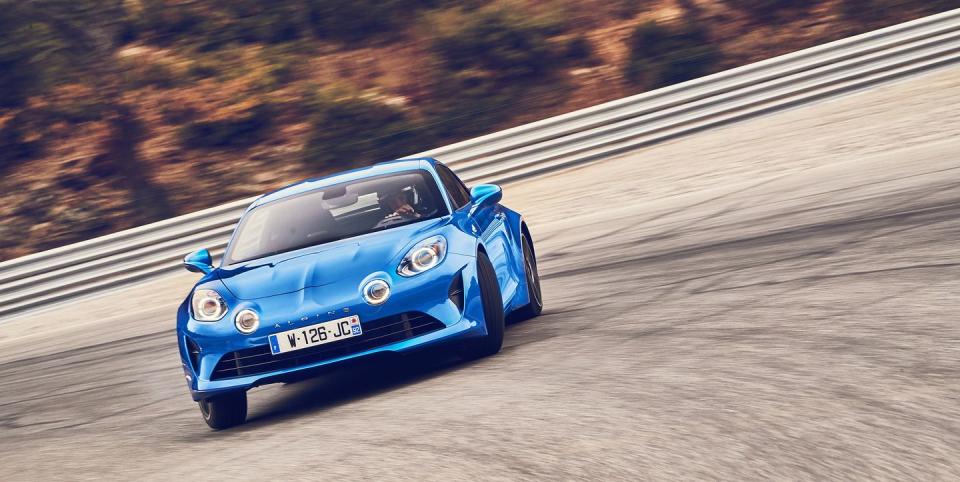
The Alpine A110 is a remarkable car and an unlikely one. It is the revival of a long-dormant French brand and the result of a curious agreement brokered by Carlos Ghosn-remember him?-for Renault and British minnow Caterham to jointly develop a mid-engine sports-car architecture.
The partnership was signed in 2012 and broke down shortly afterward. Renault took full control, and Caterham went back to making skeletal two-seaters. But the French pressed ahead with the development of an aluminum-bodied coupe, and the result is the new A110, which went on sale in Europe in late 2018. There are no plans to bring it to the United States, although, having experienced it in its native environment of the French Alps, we reckon that there really ought to be.
The new car has clearly been inspired by its namesake, the original A110, which was launched in 1963. Alpine was founded by a garage proprietor from Dieppe called Jean Rédélé, who started out racing and tuning rear-engined Renaults before starting to use the same mechanical components in his own lightweight sports cars. Competition versions of the first A110 stayed competitive throughout the car's long life, dominating many of the mountainous rally races that inspired the brand's name. It was still winning in 1973, taking the inaugural World Rally Championship for manufacturers and the first three places at the famous Rallye Monte-Carlo that year.
Now a Mid-Engined Two-Seater
The reborn A110 shares its predecessor's proportions as well as details such as quad headlights, but the big difference has been effectively hidden: The four-cylinder engine now sits mostly ahead of the rear axle rather than fully behind it. The all-aluminum turbocharged inline-four is closely related to the unit that powers the Renault Sport Mégane hatchback but is in a lower state of tune, making 249 horsepower and 236 lb-ft of torque, sent to the rear axle through a seven-speed dual-clutch automatic transmission. An impressively svelte curb weight, roughly 2450 pounds for the Première Edition model we drove, keeps things interesting. Even though it is less powerful than the entry-level Porsche Cayman, the A110 boasts a slightly more favorable power-to-weight ratio.
It's smaller than its German rival, too. The Alpine's wheelbase is 2.1 inches shorter, and, at 164.6 inches in length, it's 7.8 inches shorter overall, but its 70.8-inch width is nearly identical to that of the Porsche. The A110's roofline sits 1.3 inches closer to the ground than does the Cayman's-but the first thing we noticed on entering the cabin, beyond some neat tricolore details, was more headroom than we would have found in the Porsche.
Luxury is lacking. The Première Edition has leather bucket seats with quilted stitching and fixed backs. They look good and hold you in place during cornering, but the inability to recline means they start to bite hard after a couple of hours. The cabin is noisy at cruising speeds, with road roar getting past the minimal soundproofing and the exhaust droning at constant revs. Ergonomics are good, with a thick-rimmed steering wheel and a row of nice-feeling metal switches below the touchscreen. That infotainment system comes straight from Renault's more basic hatchbacks, albeit here with a performance-logging system. The virtual instrument cluster is configurable, engaging the transmission is managed by D, N, and R buttons on the center console, and shifting gears manually is done via paddles.
Lively Handling
Weight-saving measures are evident. There are no audio-system controls beyond those attached to the steering column, and the mirrors in the sun visors do without covers. Luggage space is split between a small four-cubic-foot stowage under the hood and an even more compact three-cubic-foot compartment behind the engine, although any bags in the back are likely to be broiled by powertrain heat if the car is driven hard.
While it's no more than adequate at the everyday business of A-to-B driving, on twistier roads the A110 proves it is exceptionally good at being a sports car. The minimalist approach has been carried through to the chassis, in contrast to the typical logic by which sporty models get harder suspension settings and an abundance of technology. The Alpine uses a control-arm suspension front and rear, but there is no limited-slip differential or adaptive dampers, and the 12.6-inch brake rotors look modest compared to the pizza plates that normally lurk behind the wheels of sports cars.
The A110 feels soft, too-surprisingly so at first. Even with a seating position so close to the ground, there is noticeable body roll under cornering loads. You quickly learn that this doesn't matter, however, as the dampers do an excellent job of keeping secondary motions in check. The Alpine rides out bumps with no drama, yet it hangs on gamely in long sweeping curves. The electrically assisted steering feels light-even turning the car to its punchiest Race setting doesn't liberate any increase in sensation-but it is quick and delivers highly accurate responses, allowing the car to be placed on the road with what feels like inch-perfect precision.
The engine does little to disguise its proletarian origins. It fizzes and zings once unleashed, pulling hard beyond a hint of low-down turbo lag and snorting its way happily toward the 6250-rpm rev limiter. But it is never melodious, and a fair amount of the exhaust noise seems to get trapped in the back of the cabin at higher revs. Even so, there is no doubting its effectiveness. We can't think of a car with similar power that feels faster, and the benefits of the low weight are clear in terms of the way the car accelerates. We expect Alpine's zero-to-62-mph claim of 4.5 seconds to be confirmed if we were ever to test an A110. The dual-clutch gearbox shifts cleanly in response to the paddles but lacks the snap of Porsche's dual-clutch. Drive does a decent impression of a torque-converter-equipped automatic. Sadly, there won't be a manual option.
Traction is outstanding, but the A110 never feels as if it has too much grip from its very modest-width 18-inch Michelin Pilot Sport 4 tires, sized 205/40 front and 235/40 rear. The engine's full output can be deployed early and often. In tighter turns, there is rarely any indication that the rear tires are running short on grip, and altering the car's cornering line requires only small adjustments to the throttle. It's not a natural drifter-indeed, it takes deliberate action to get the car sliding-but on a twisting, narrow road it feels both hugely secure and involving, a measure rawer and more direct than a base 718 Cayman. Brake-pedal feel is a little soft for our taste, but the system coped with repeated heavy applications heading down an Alpine pass without complaint.
The Alpine brand entered its 23-year hiatus when the A610 was retired in 1995, after years of minimal sales. The model had moved far from the brand's origins in elegant featherweights, being powered by a twin-turbo V-6 and weighing more than a contemporary 911 Carrera. Alpine continued as Renault's in-house tuning arm, responsible for its RS models, but bringing the brand back is a significant move. The A110 suggests that lessons on mission creep have been learned and that a Lotus-like dedication to minimalism will guide future strategy.
Ordinarily we end stories like this one with polite regret that the U.S. is denied such cars because of the vagaries of the international auto business. That's not enough here. Book a transatlantic flight and beg, borrow, or steal a turn in an A110. You won't regret it.
('You Might Also Like',)

 Yahoo Autos
Yahoo Autos 